The Inca Trail Hike to Machu Picchu – EVERYTHING You Need to Know Before You Book & Go!
Are you ready for the adventure of a lifetime? The hike to Machu Picchu on the Inca Trail is one of my most incredible travel experiences to date.
This legendary trek takes you through the heart of the Andes, offering jaw-dropping views and a chance to walk in the footsteps of the ancient Incas… it then ends at the awe-inspiring Machu Picchu.
Today’s post is all about the Inca Trail hike to Machu Picchu. It covers the best time to go, how to prepare, what to pack, and what to expect along the way. This guide will cover EVERYTHING you need to make your Inca Trail experience unforgettable.
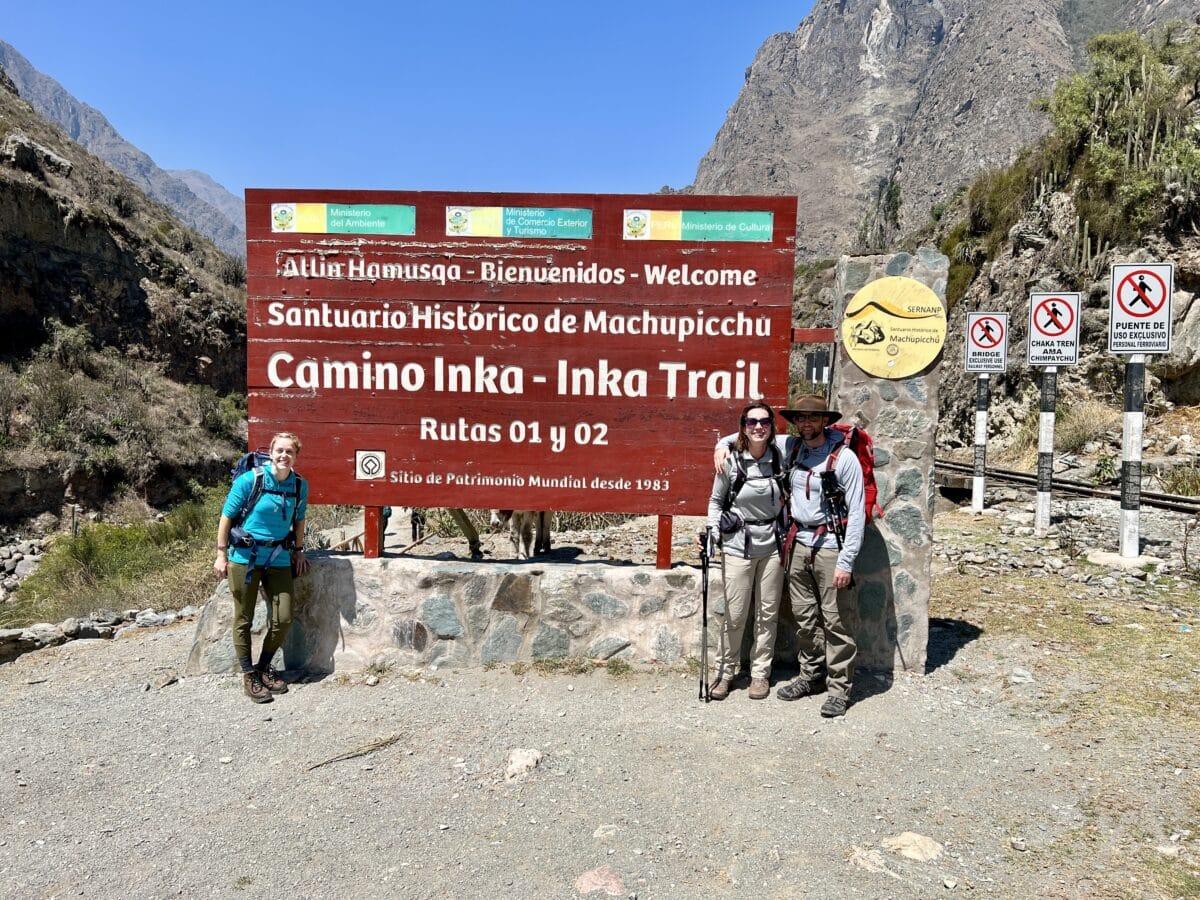
*Disclosure: Have Clothes, Will Travel uses affiliate links. Meaning, if you click a link and make a purchase, Have Clothes, Will Travel gets a very small commission at no extra cost to you. Thank you for supporting the brands that make this blog possible!
So, What is the Inca Trail?
The Inca Trail is one of the most famous treks in the world. It’s a 4-day, 3-night hike that is about 26 miles or 43 km long. Which doesn’t sound all that bad… However, most of this hike is uphill or, more specifically, walking up ancient stone stairs. You’ll also be dealing with altitude, as this trail is anywhere from 2,200m to 4,200m (or 13,780ft) above sea level.
The hike itself starts just outside of Ollantaytambo and ends by passing through the Sun Gate – which provides incredible views of Machu Picchu. Only those who hike the Inca Trail get to pass through the Sun Gate at sunrise.
My Inca Trail YouTube Video:
Figuring Out the Best Time to Hike the Inca Trail
Now, if you want to do the Inca Trail hike, the first thing you need to decide is when you want to do it and whether you want to go in the dry season or the rainy season.
Booking in the Dry Season vs. Rainy Season
The dry season runs from April to October and is generally considered the best time to do this hike. During these months, you can expect sunny days and clear skies. Temperatures during the day hover around 66°F (19°C).
However, don’t let the term “dry season” fool you. Even during these months, you should be prepared for some rain, especially in April and October. The nights can get quite chilly, with temperatures dropping to around 34°F (1°C) in June and July, which are the coldest months. Dry season is, of course, the busiest season to do this hike, so expect to be sharing your hike with lots of other adventurers, too.
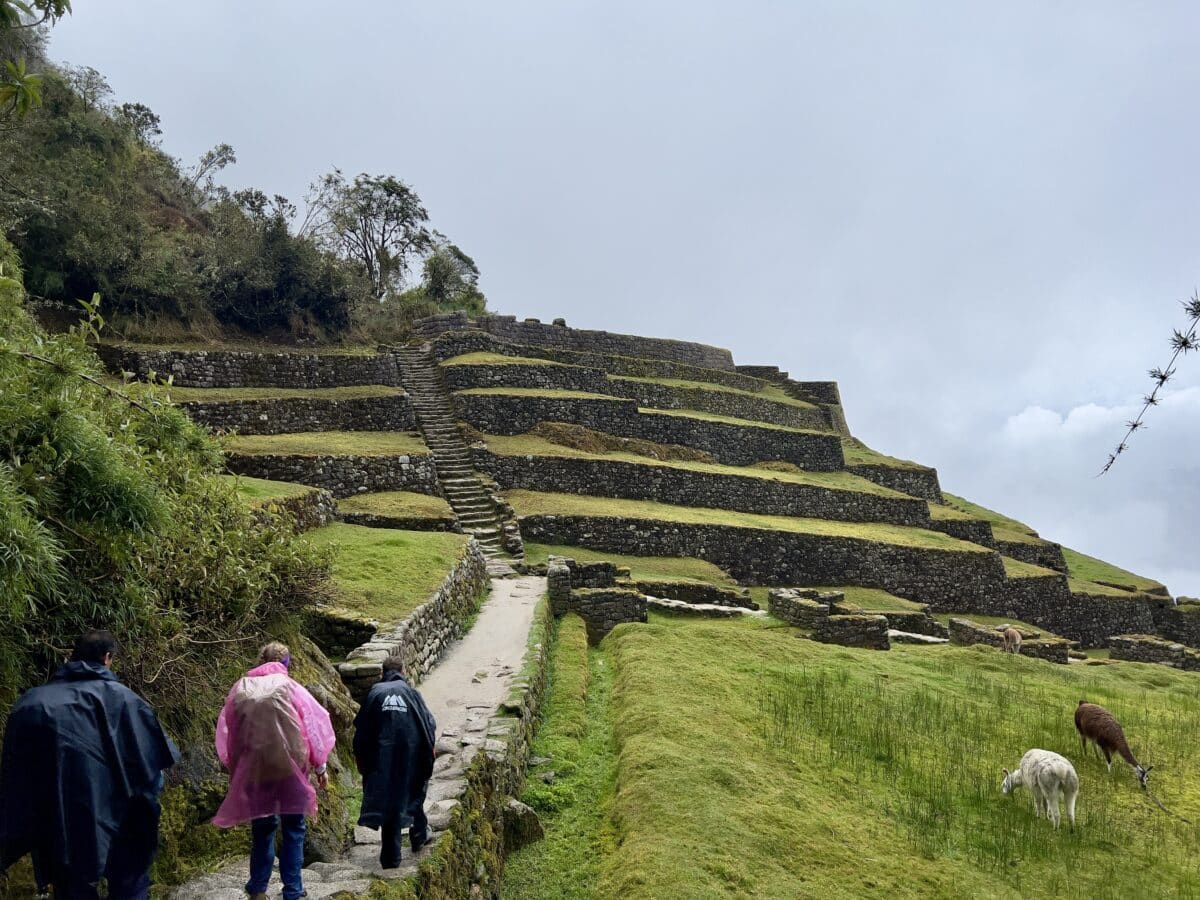
Now, the rainy season is from November to March and brings its own set of challenges and rewards. You’re likely to encounter more frequent and heavier rainfall, which can make the trail slippery and muddy. However, this is also when the mountains are at their greenest, offering a beautiful, vibrant backdrop for your trek. There are also far fewer people at this time of year…I personally did this hike in late November and did have one morning that was very rainy, but otherwise, the weather was quite pleasant… and the trail was quiet!
The temperatures were in the 60s and low 70s Fahrenheit during the day and would drop to the low 40s at night.
It’s also worth noting that February is the wettest month, and the Inca Trail is closed throughout this month for maintenance, so you can’t do this hike in February.

Booking in Advance
Regardless of when you choose to do the hike, booking well in advance is a must. The Peruvian government limits the number of hikers on the Inca Trail to 500 per day, including guides and porters. This leaves only about 200 spots available for tourists daily.
You should book your trek at least 5-6 months in advance. Permits are issued on a first-come, first-served basis and can sell out quickly, especially for popular dates.
And you need to book with a licensed guide. You can’t do this trek by yourself! The Peruvian government mandates that all trekkers must be accompanied by a licensed guide to hike the Inca Trail to Machu Picchu.
We had booked our trek through Baboo Travel, and they had Condor Travel as our guide for the hike. We were super happy with Condor Travel for this hike!
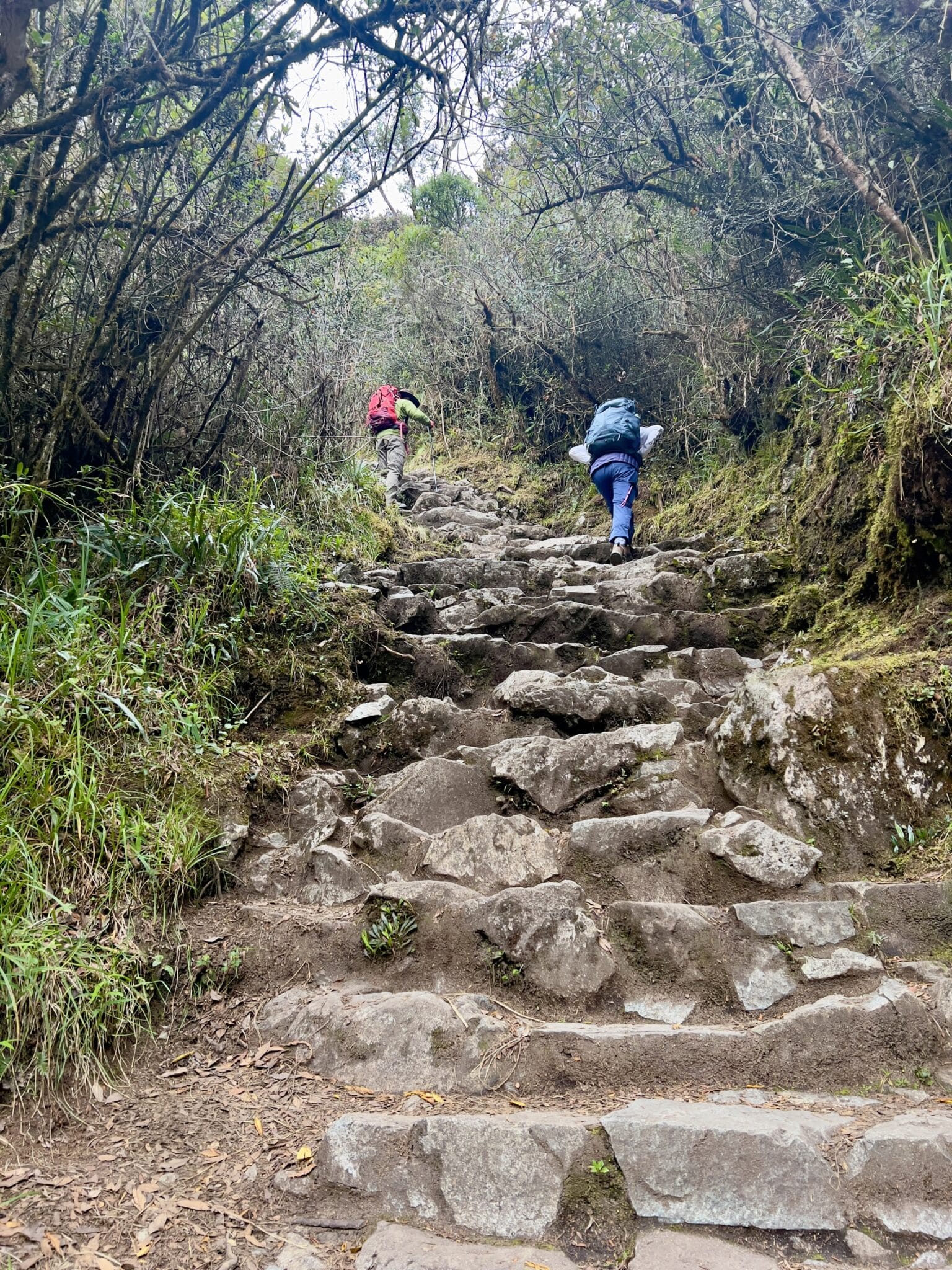
Preparing for the Inca Trail
Training Regimen
To make sure you enjoy your Inca Trail experience, it’s important to put in the right physical preparation, and of course, it’s always important to consult your doctor before signing up for this hike and beginning a new training regime.
So, the trek has a lot of steep stairs, both ascending and descending, which can be challenging for many people–myself included! I personally found it harder to descend than ascend those stairs!
Your training should focus on building endurance, leg strength, and overall body strength.


What we did…
I am someone who really likes to work out, running, weightlifting, yoga, you name it I do it 5-6 days a week. So, I didn’t change my normal training too much besides adding a weekly 1-2 hour hike into my training schedule with my backpack.
My husband on the other hand does not enjoy exercise and started from scratch. He started about 14 weeks before the hike and did some rowing for cardio a couple of times a week and then would do 1-2 hikes a week. These hikes would range from 1-2 hours walking up and down steep inclines with his backpack.

And we live in Wisconsin and don’t have mountains, so we just found the steepest hill near us and hiked up and down it.
We both felt we were very prepared for the Inca Trail. Sure, we were tired at the end of each day, but it was “good” kind of tired, not “I’m going to die tired.”

So, I would say it’s a good idea to begin your training at least 12 weeks before your trip, especially if you’re a beginner. Aim to train a few times a week, gradually increasing the intensity and duration of your workouts. Here’s some ideas to get you started:
- Pick a Cardio exercise you like: This could be jogging, brisk walking, cycling, or rowing to build up your stamina.
- Strength training: Focus on exercises that target your legs and core, such as squats, lunges, and planks.
- Hiking practice: If possible, go on regular hikes, gradually increasing the distance and elevation gain.
- Stair training: Find a set of stairs and become friends with it. This will help prepare you for the tons of stairs on the trail.
As your trip gets closer, start training with a weighted backpack, starting light and building up to the weight you will be using on the hike.

What to Pack for The Inca Trail
Your tour company will likely provide a porter and a small duffel bag to pack your belongings in that you want the porter to carry. The tour companies will also provide your food and tents. So, you won’t have to worry about carrying all of your belongings and gear for this hike!
The weight limit per person for which a porter will carry will vary depending on your tour company/group size. 20 KG is the maximum weight a porter can legally carry.
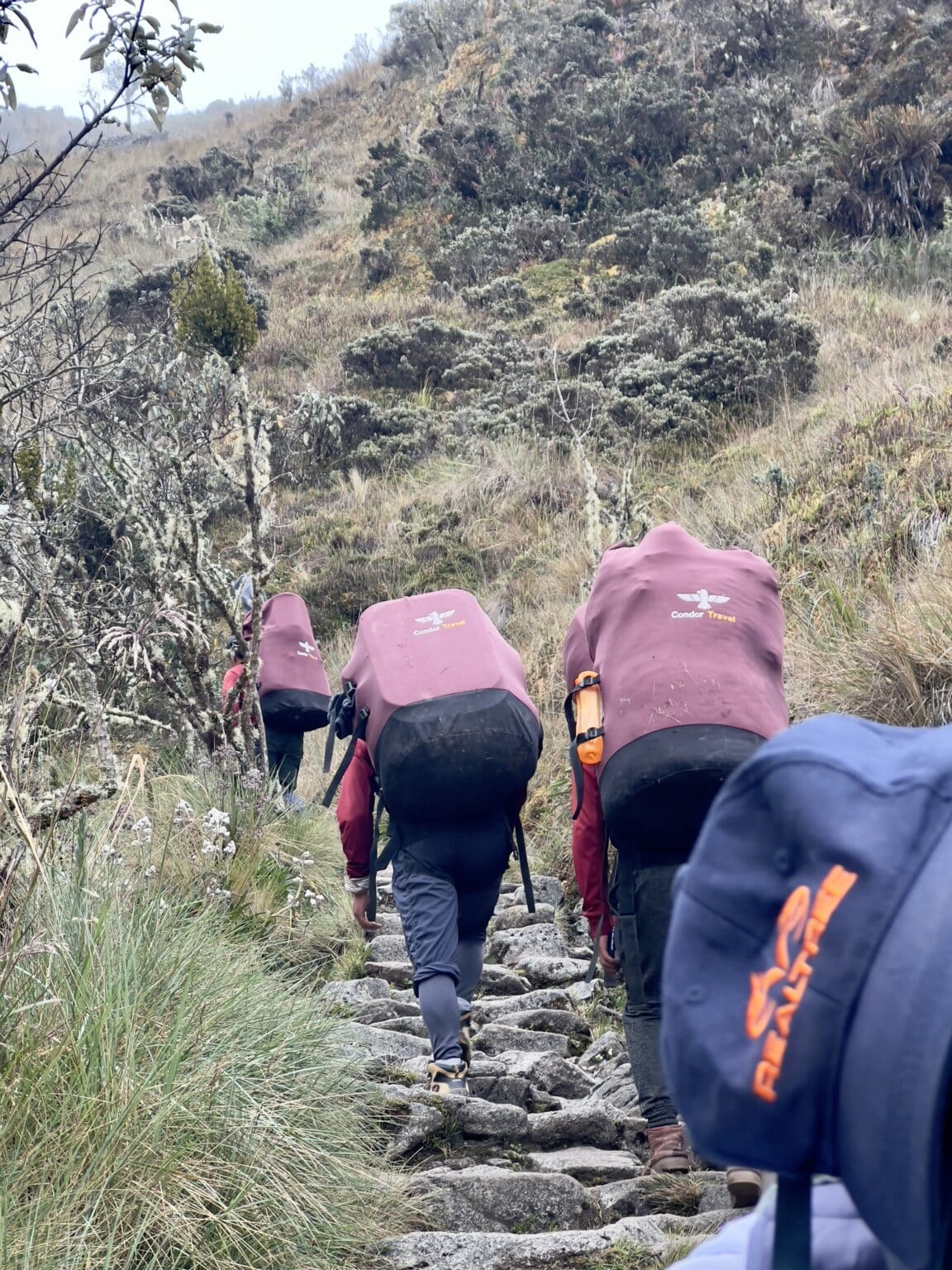
Then, the allowance per person will depend on the size of your hiking group. 5 KG is the typical weight allowance for personal items (in that duffel bag) for the majority of hiking companies. But again, double-check with yours before you pack!
I am going to link to my really detailed Inca Trail packing list here, complete with a free printable, but right now; I will give a quick overview of some important things to bring and wear!
- The most important thing you need for the Inca Trail is a good pair of hiking boots with ankle support that you have broken in. Do not bring new boots on this hike! It’s a good idea to have water-resistant boots, too, so you don’t end up with soggy socks if it starts to rain.
- Next, a day backpack—This is what you will carry throughout your hike with the things you will want throughout the day, such as extra layers, snacks, water, sunscreen, camera, etc. It is up to you how much you want to carry. Most people on our hike found the 24L backpack to be sufficient. We also had backpacks with bladders for our water, which made it a lot easier to stay hydrated on the hike.
- Then you’ll want comfy hiking clothes that you have tested on a hike!

Other things that are good to bring:
- A headlamp
- A lightweight sleeping bag or sleeping bag liner if your tour company provides sleeping bags
- Power bank and phone charger
- Deodorant
- Body wipes – this will serve as your shower on the hike
- SUNSCREEN
- Hand Sanitizer
- Bug spray
- Small lotion and lip balm
- Toilet paper! This is very important (keep it in a ziplock bag so it doesn’t get wet)
- Dog poo bags are good to have along to put your toilet paper in if you need to use the trail as your toilet. (Or if you need to #2 along the trail…) I also like having them along to collect my trash throughout the hike.
- Passport! You do need this along at both the start and end of the trail
- Cash for tipping your guide and porters as well as for snacks along the way.
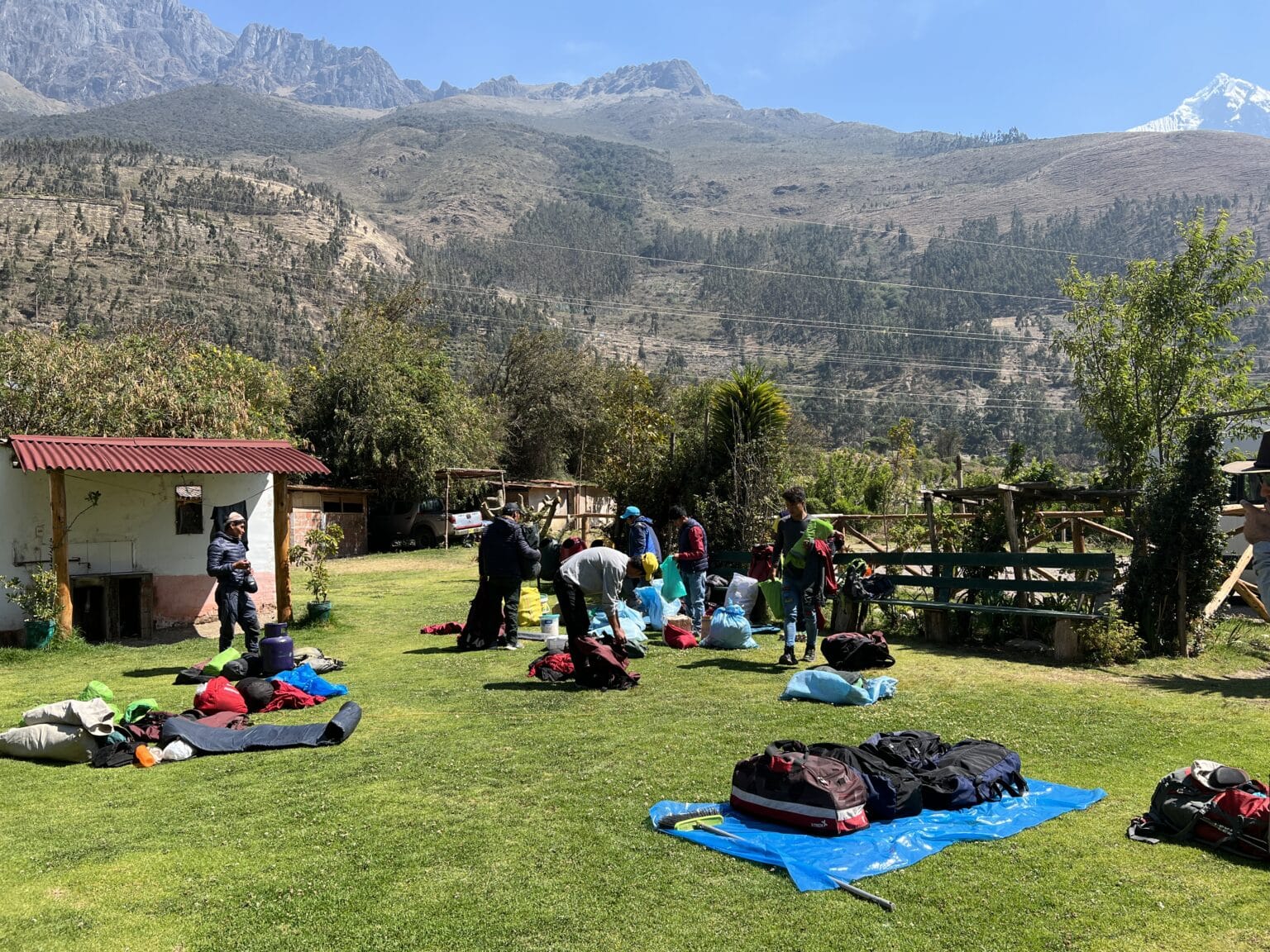
Tipping on the Inca Trail
While we are talking about cash for tipping…each person typically contributes between 100-200 soles to the porters/cooks. You’ll do this on your final night, as they will not accompany you to Machu Picchu on the 4th day.
Then, each person tips around 50 soles for your main guide and if you have an assistant guide too, 25 soles is for them. Of course, tipping is not mandatory, and you can definitely give less, more or nothing at all, depending on the level of service you feel you had.
We were super happy with our porters, guides, and cooks, so we did all tip them.
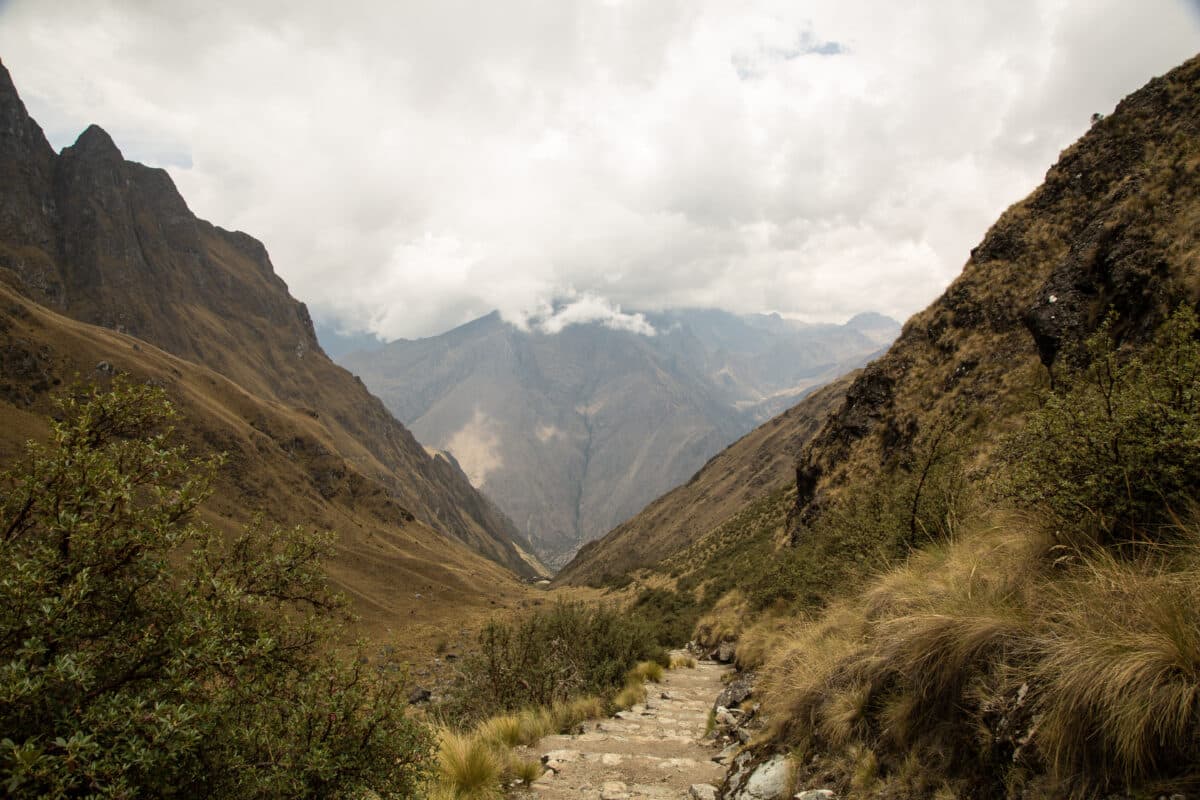
Altitude Acclimatization
The Inca Trail reaches elevations of up to 13,828 feet (4,215 meters), so it’s important you acclimate to this higher altitude before you start this hike. Here are some tips to help your body adjust:
- Arrive early: Spend at least 2 days in Cusco before starting your trek. This gives your body time to adapt to the high altitude.
- Stay hydrated: Drink plenty of water and avoid alcohol, which can worsen altitude symptoms.
- Take it slow: During your acclimatization period, take leisurely walks around Cusco or the Sacred Valley.
- Consider altitude sickness medication: Consult your doctor about taking altitude sickness pills as there are side effects with these. I had altitude sickness the first time I went to Cusco, so I took this medication on this trip, and it was a game-changer for me. The altitude did not bother me one bit on this hike or while in Cusco!
However, remember, altitude affects everyone differently. Listen to your body and don’t hesitate to inform your guide if you’re experiencing symptoms of altitude sickness.

Hiking the Inca Trail to Machu Picchu – What to Expect
The Bathroom situation
First things first, the bathrooms were what I was most interested in when I was researching “What to Expect on the Inca Trail.” Most tour companies will bring along a camping toilet with a privacy tent, which you will use at your campsites (see photos below). On our first night, there were also outhouses for us to use near our tents. There will also be a couple of public bathrooms along the way. Some of these required a small cash fee.

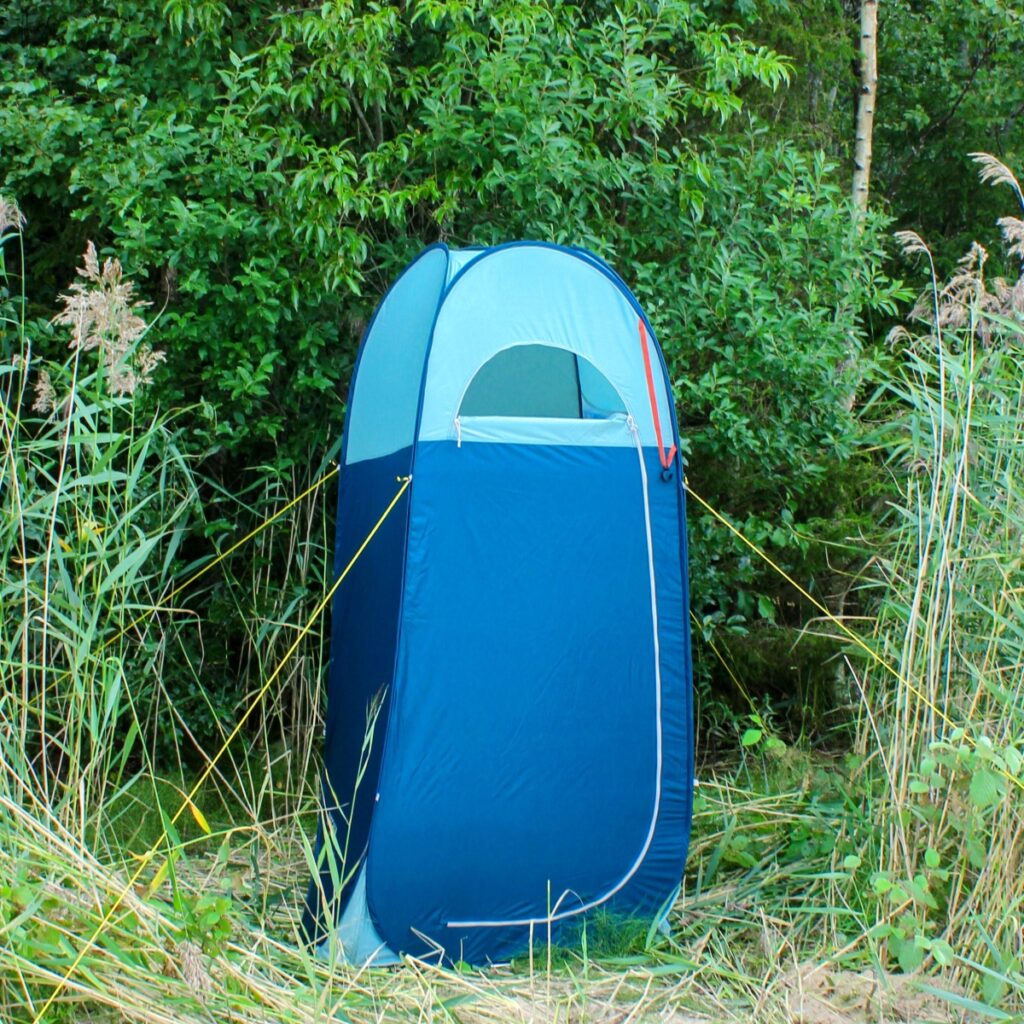
There was actually not a single time that I had to use the great outdoors as a toilet. By the time I had to go, there was a bathroom of sorts that I could use.

Some Inca Trail guides I read also mentioned that there are cold showers along the way. None of these were open, though, when we did this hike, and frankly, it was typically around 40 degrees Fahrenheit at night, so I was not interested in taking a cold shower anyway. Being smelly for a few nights wasn’t all that bad.
The Food
Next, I was most interested in the food. And of course this will vary from tour to tour, but everyone seems to agree, that the food served on this hike is incredible! It’s amazing what they can make along the trail. Our last night we even had a cake! In my opinion, each meal was amazing. Our tour company even provided snacks.
Some of the food on the Inca Trail…
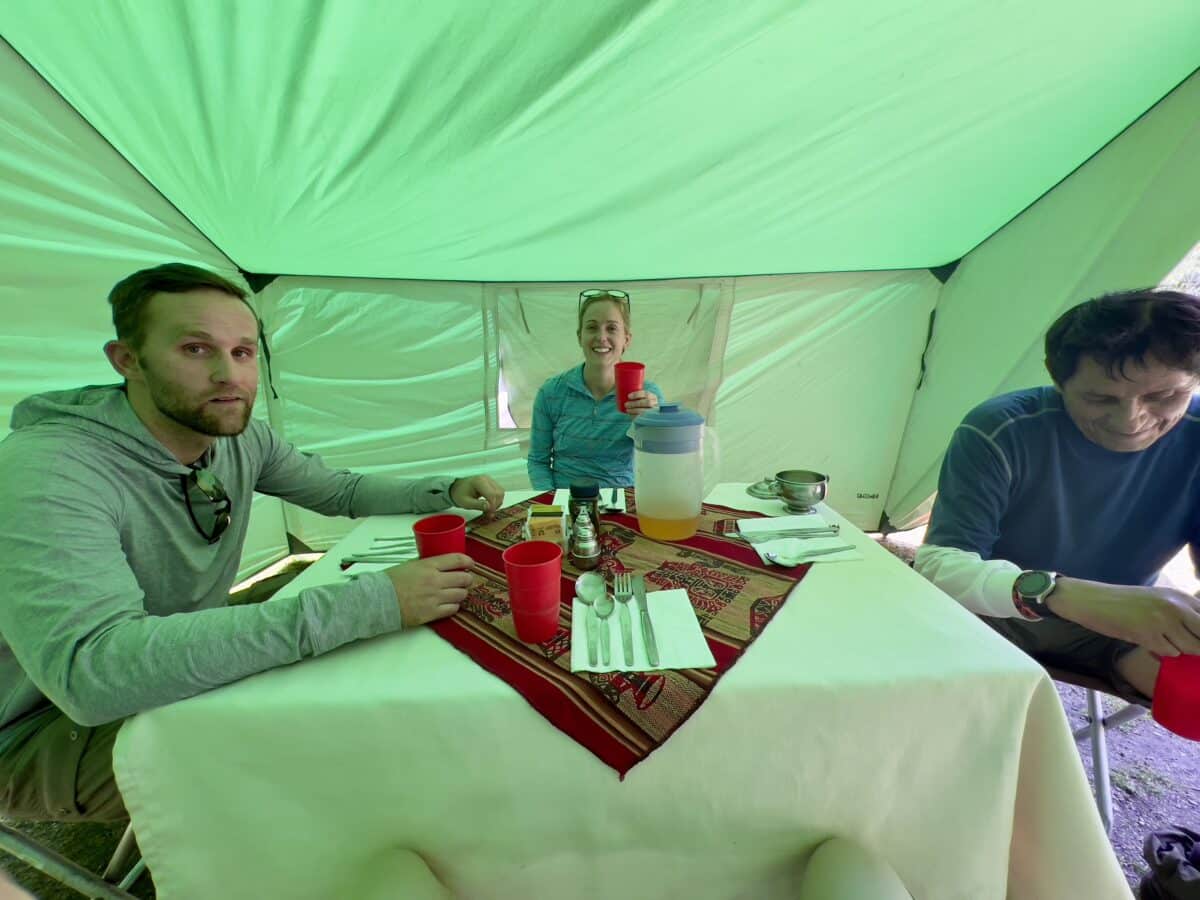

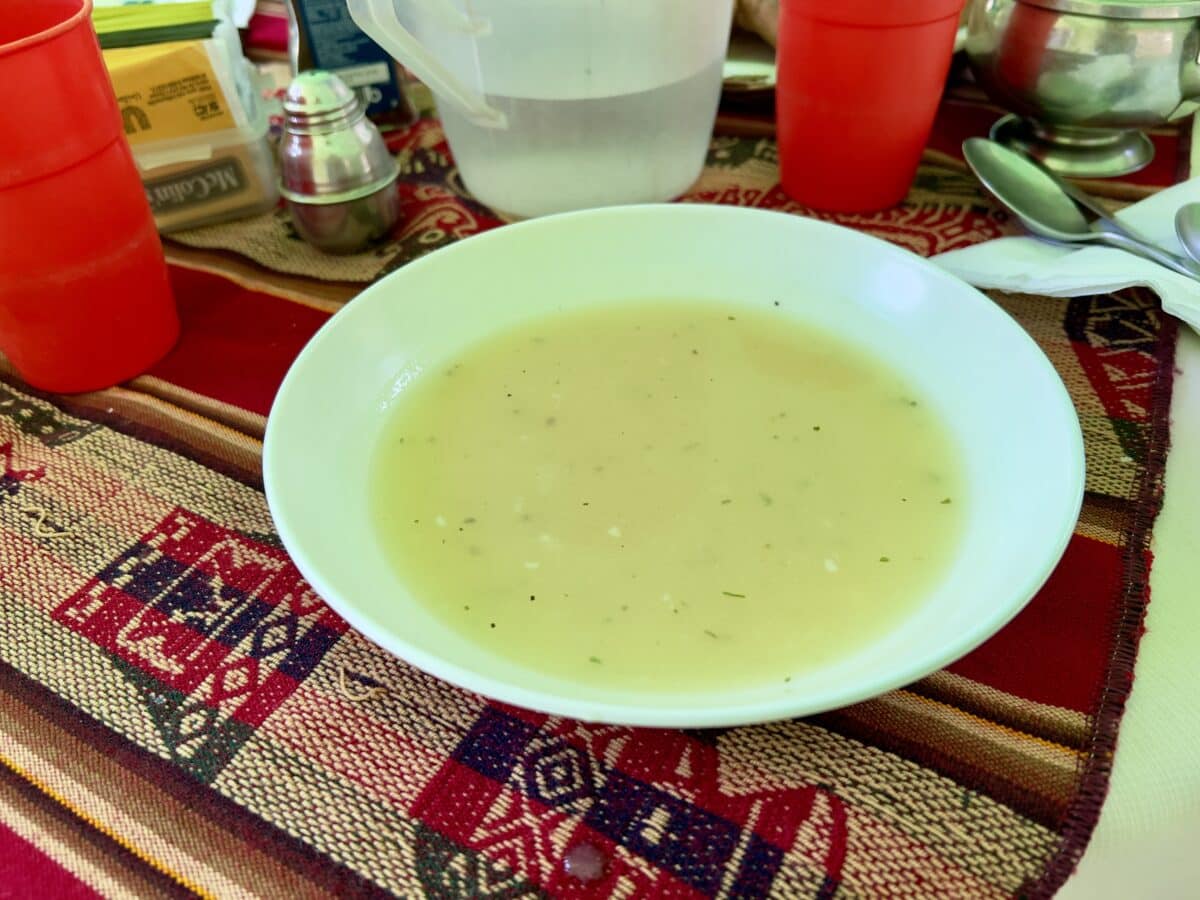
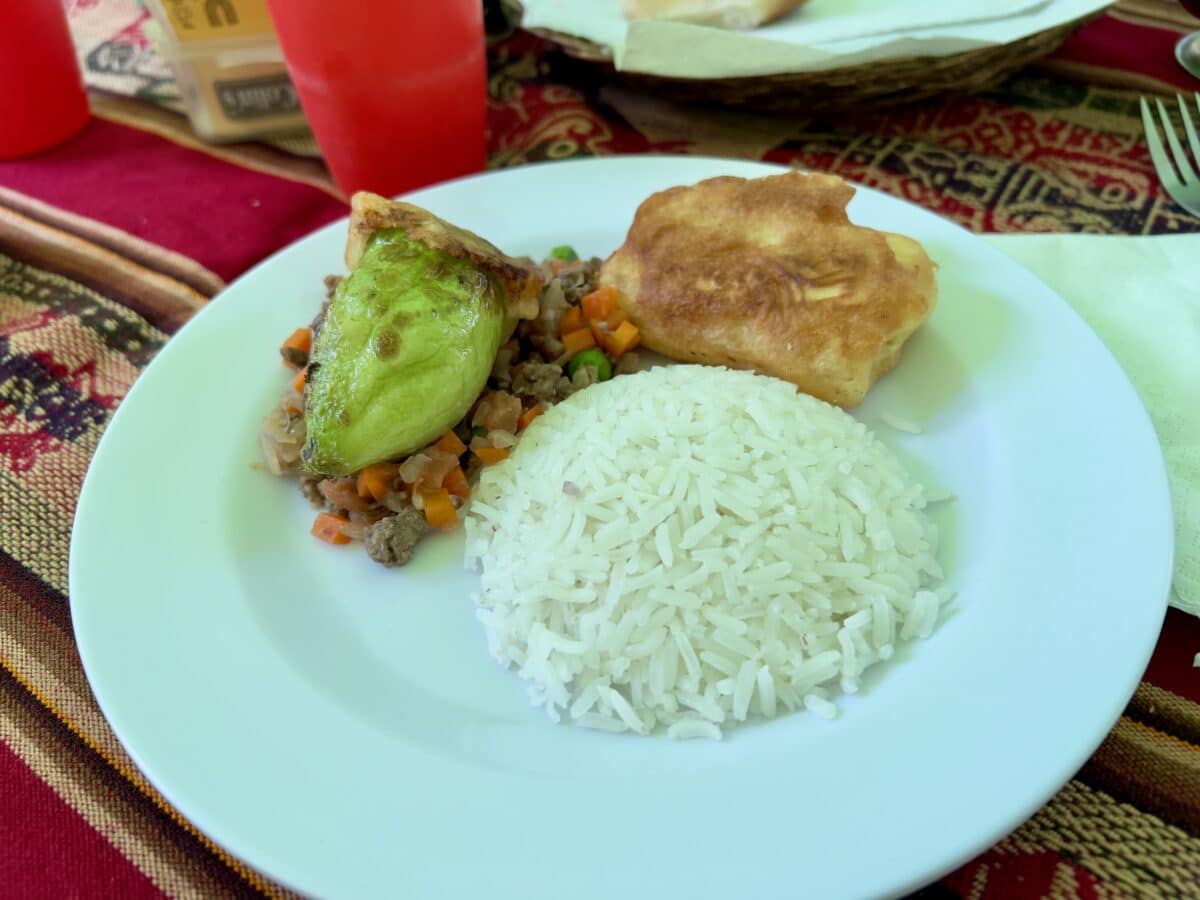


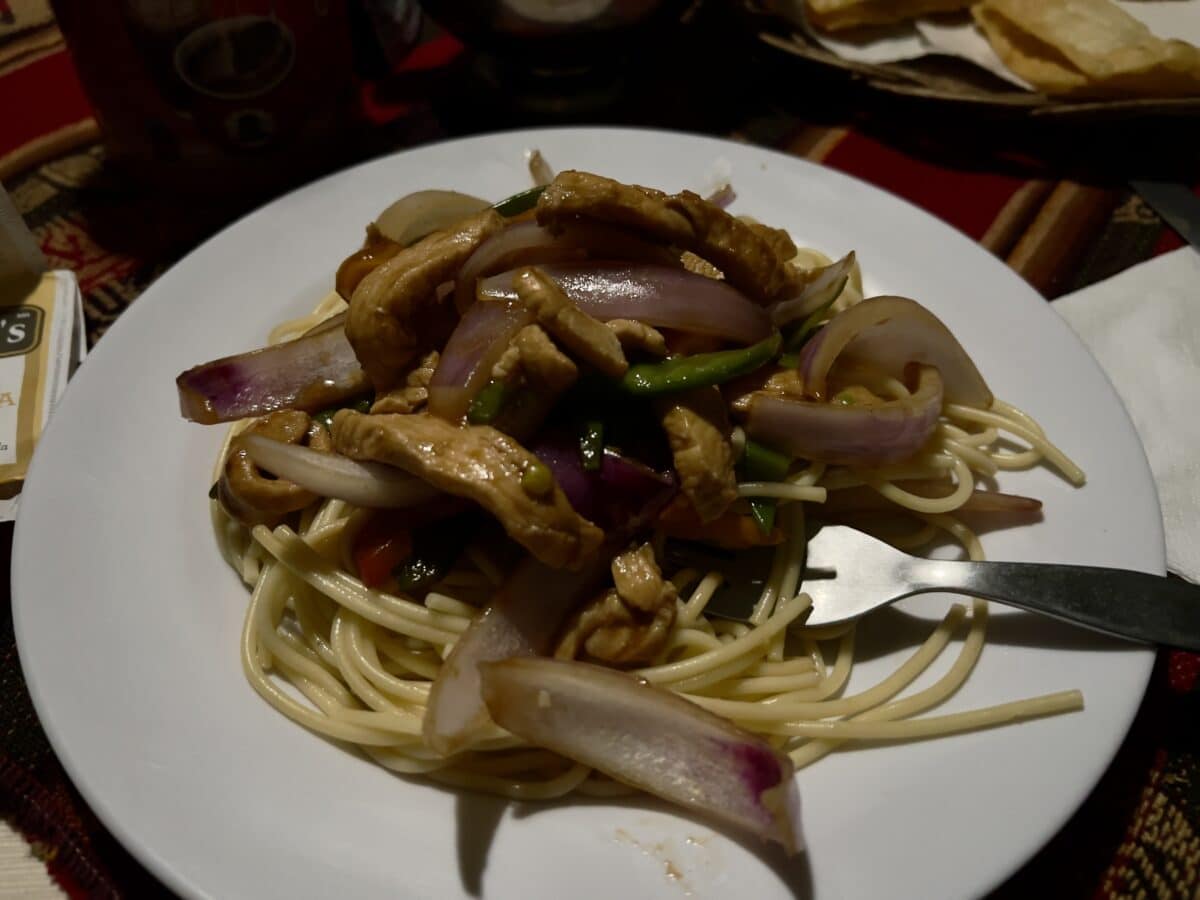

You won’t have to worry about being hungry on the trail. Just be sure to communicate any food allergies when you book the trek.
Getting Sick
Whether it’s the altitude, food poisoning, the heat, etc., getting sick on the Inca Trail is not uncommon and something to keep in mind. It seems that this typically happens for most hikers by the first night into the second morning. At this point, you might have to make a decision to turn around, depending on how sick you are. It’s really important that you listen to your body.
My friend did get sick the first night and into the second morning. Amazingly, she pushed through with the help of some over-the-counter meds, determination, simply taking her time, and everyone pitching in to help carry her bag. Personally,if I had been that sick, I think I would have turned around! But everyone’s body is different.
The Hike Itself…
Now, here is an overview of what to expect on the hike itself!
Day 1: Cusco to Wayllabamba
The Inca Trail adventure begins with an early wake-up call in Cusco. Enjoy your last hot shower for the next few days! The day starts with a bus ride to the trailhead, which is just outside of Ollantaytambo; here, you’ll get your gear situated, meet your porters, and head out.
Starting the trek
But before hitting the trail, you’ll go through a checkpoint where you’ll need to present your passport and permit.
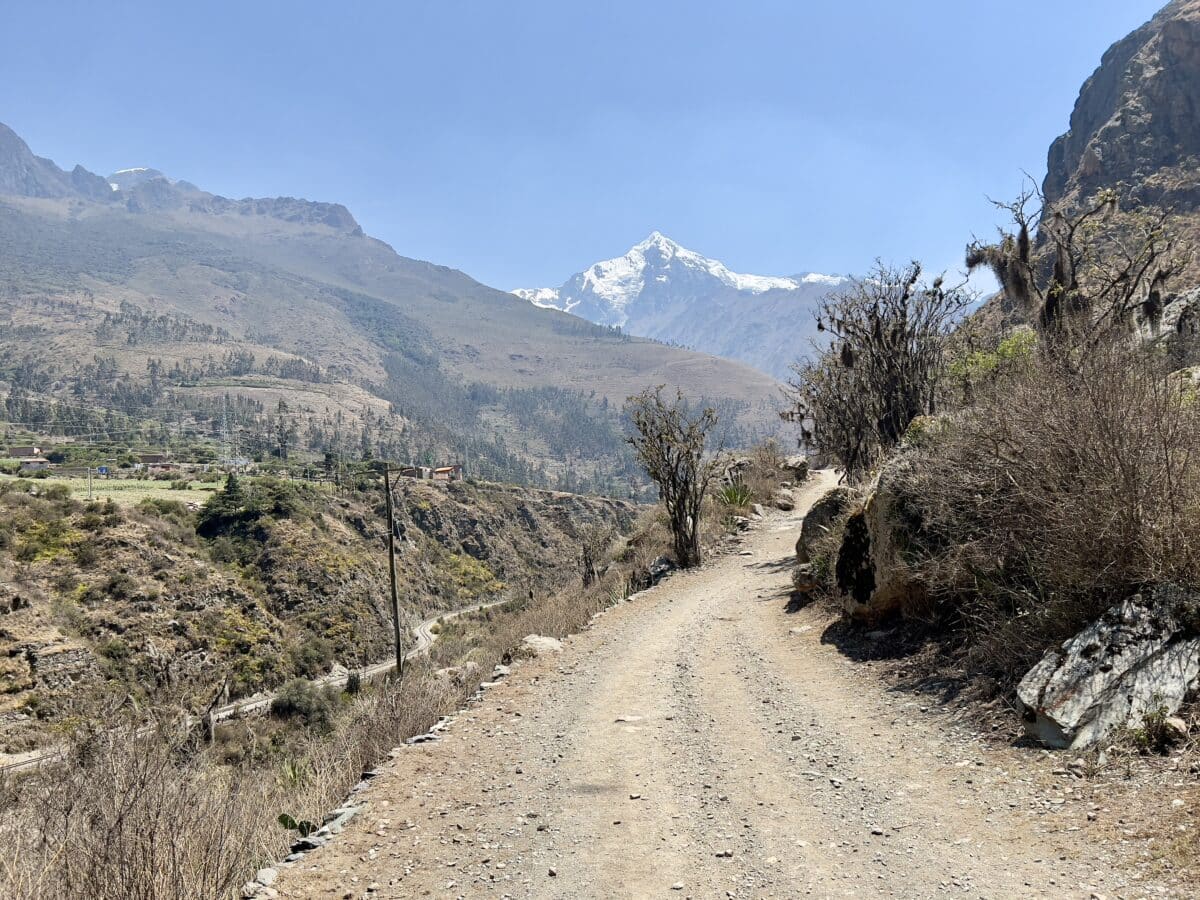
The trail starts relatively easy, with a dirt path that’s much flatter than what you’ll encounter in the coming days. This gentle beginning serves as a good warm-up!
For us, this was also the warmest day of the trek. We felt we could have been in tank tops and shorts that day.
We hiked for about 5 hours on the first day.

First campsite
Then, the first night is spent in the community of Wayllabamba. You’re essentially sleeping in people’s backyards for this portion of the hike. There is even a little store where you can buy snacks, beers, and wifi.
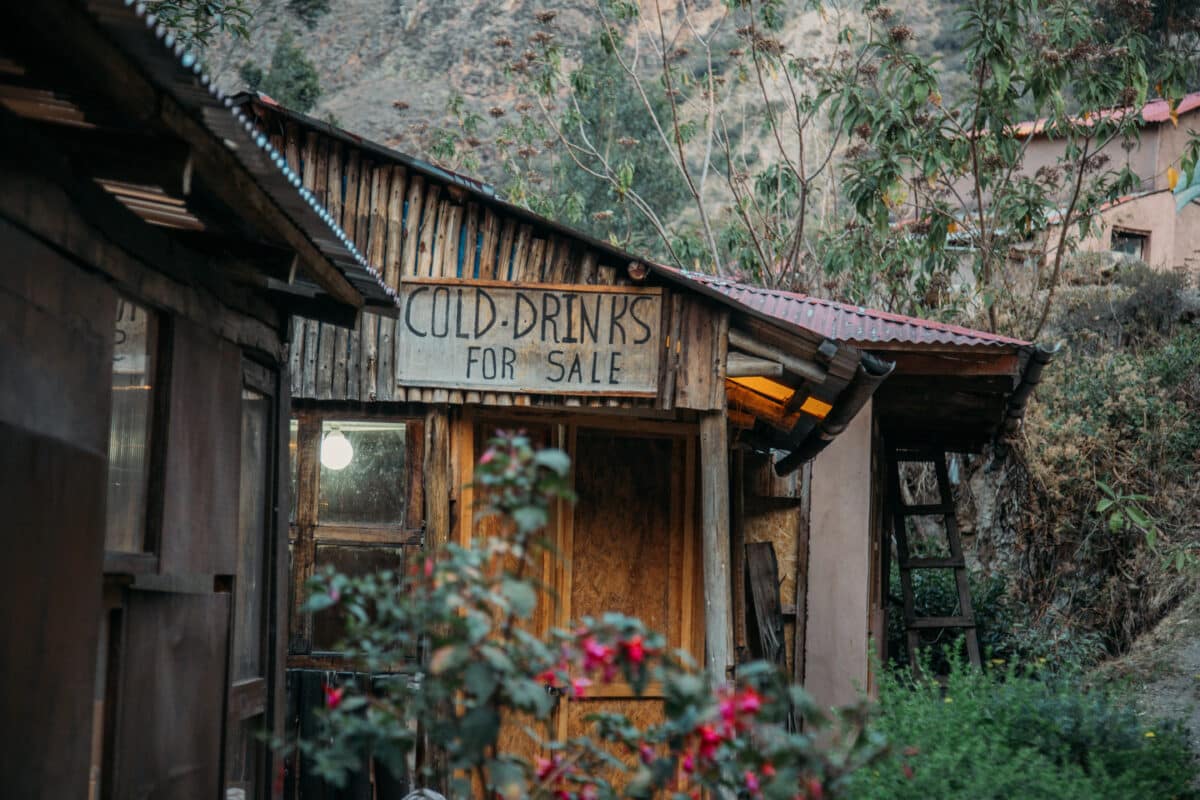

This is a good night for earplugs, as you can hear dogs, other hikers, livestock, etc., on this night!
Day 2: The Challenging Climb
The second day of the Inca Trek is notorious for how physically challenging it is, but it’s also the day that will push you to new heights – quite literally.
Dead Woman’s Pass
The day begins early, usually around 5 am, with a hearty breakfast to fuel you for the journey ahead. The first four hours of the hike are an uphill climb towards the infamous Dead Woman’s Pass.

At 4,215 meters (13,828 feet) above sea level, Dead Woman’s Pass is the highest point of the Inca Trail. The final approach can be particularly challenging, with steep Inca stone steps that seem to go on forever. But don’t be discouraged – the sense of accomplishment when you reach the top is unbeatable. And the views here are amazing!
This was also the chilliest portion of the hike, as Dead Woman’s Pass was quite windy. I had on all of my layers for this day.

The Descent
After conquering Dead Woman’s Pass, you’ll begin your descent. This two-hour downhill trek can be just as challenging as the ascent, which honestly, for me this part was more challenging as I have issues with my knees.. Your trekking poles will be lifesavers here, and help to take some pressure off your knees.
We hiked for about 8 hours total on this day.
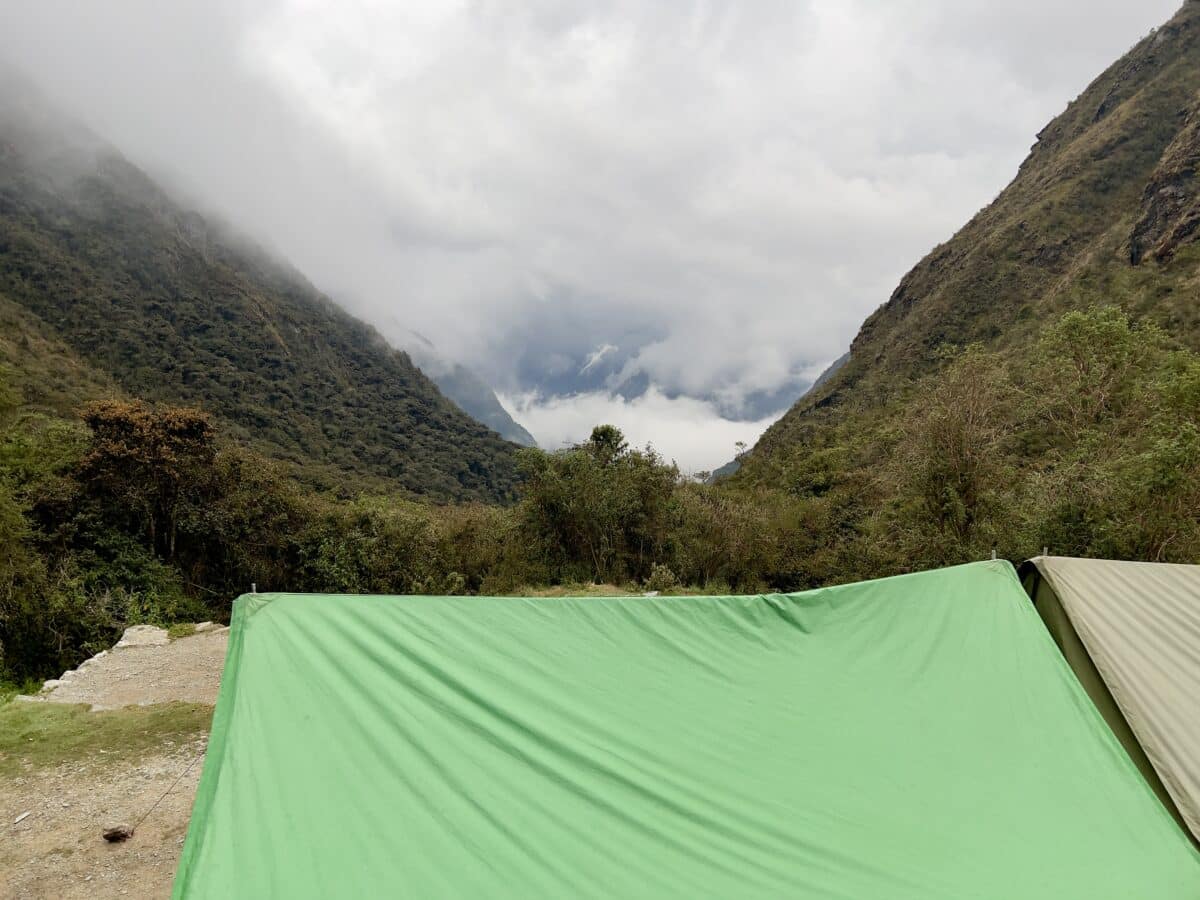

Campsite at Chaquicocha
The campsite on the second night is quite remote and has spectacular views. This was a chilly night for us, but it was my favorite by far. I loved how quiet and serene this campsite was!
Day 3: Cloud Forests and Inca Ruins
Day 3 will feel like a cakewalk after surviving Dead Woman’s pass! This day is often described as the best of the entire Inca Trail journey, as it is a perfect blend of breathtaking scenery, fascinating ruins, and relatively easier hiking.

This was my personal favorite day, as the Inca sites along the way were incredible to see. There were even some llamas roaming through them!
This was our slowest day of hiking, just because we were constantly stopping to admire the views and take photos. We hiked around 9-10 hours this day, but again, we were moving a leisurely pace.

This was also the only day we had hard rain! We were very grateful to have along raingear on this day!
Final Campsite
The last night is at the Wiñay Wayna campsite. This campsite is a hive of excitement and anticipation as trekkers from various routes converge here on their last night before the grand finale.
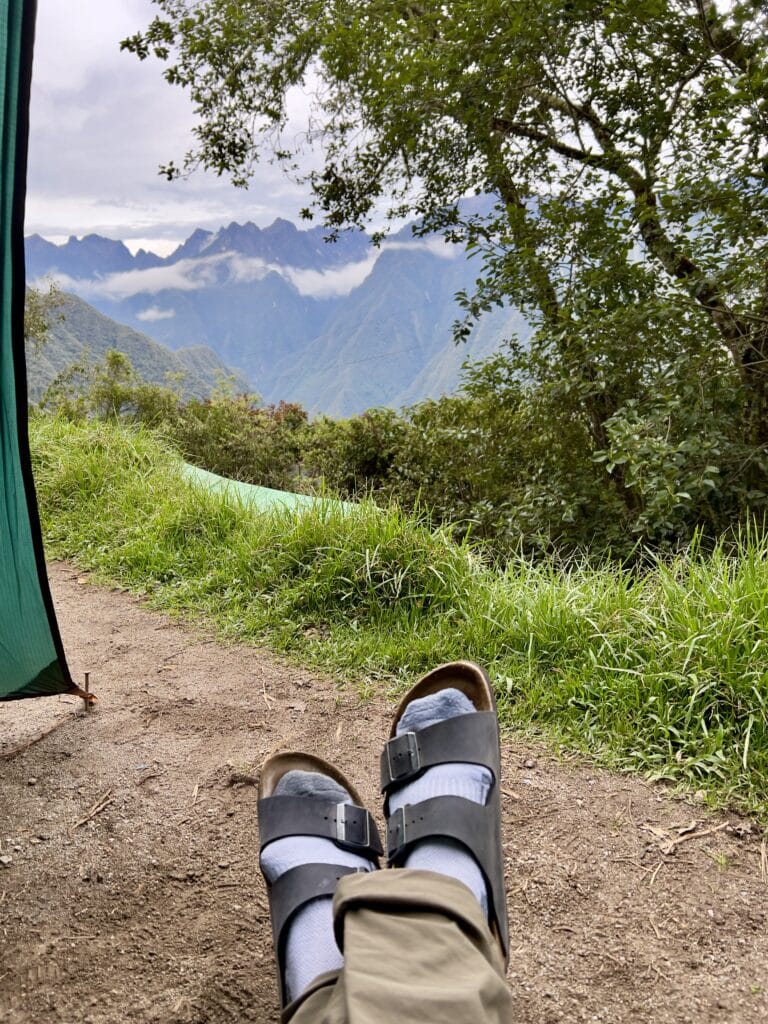
The campsite offers basic facilities, including toilets and cold showers. However, the showers were not open when we did this hike. We just used our body wipes as showers.
Some tours, like ours, even provide a small farewell celebration here, giving you a chance to thank your porters and cooks who have supported you throughout the journey. Again, this is the night you tip your cooks and porters.
This is another night you’re probably going to want your earplugs, as trekkers will likely be staying up much later as they celebrate!
Day 4: Machu Picchu at Last
Sun Gate arrival
The final day on the Inca Trail begins with an early start. It will be dark, and you’ll need a flashlight or, better yet, a headlamp.
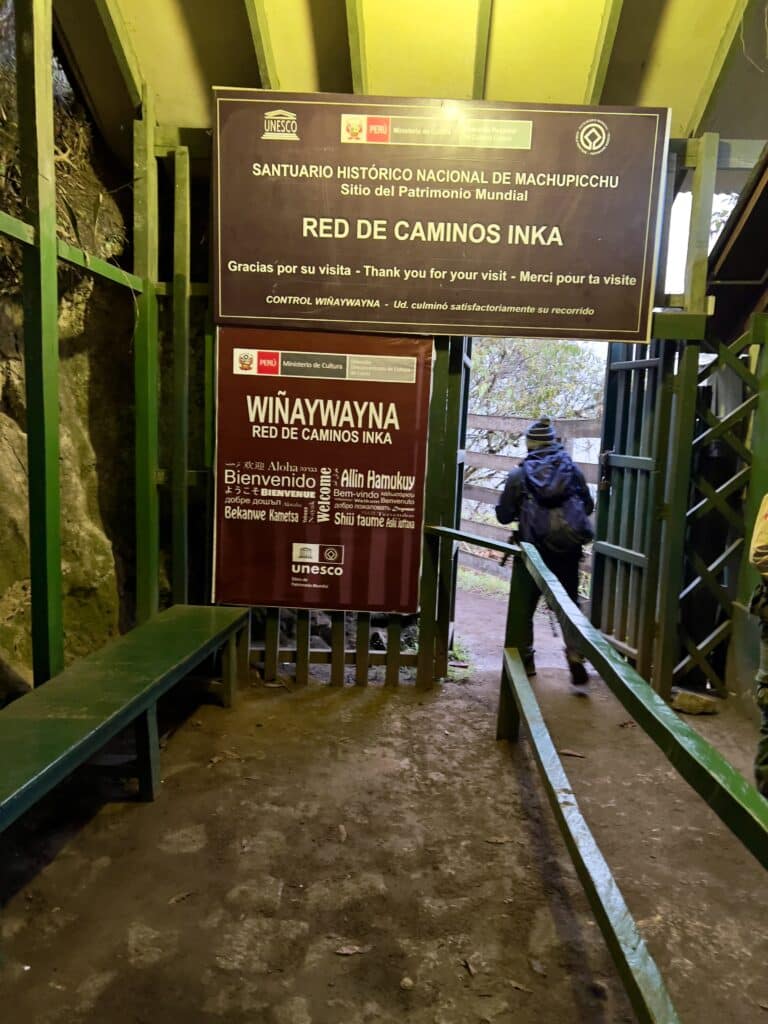
You’ll first have to pass through another checkpoint point and show your permit and passport again. We arrived at the checkpoint before it opened and had to wait for a little while for it to open.
Then, it’s off to the Sun Gate! This hike is not too difficult, other than a few minutes of climbing the “monkey stairs.” That was the only challenging part of this day.

The excitement of getting to the Sun Gate has most hikers moving at a pretty brisk pace! This morning was a lot of fun…. Even though when we arrived at the Sun Gate, Machu Picchu was completely covered in clouds and fog, and we couldn’t see anything.
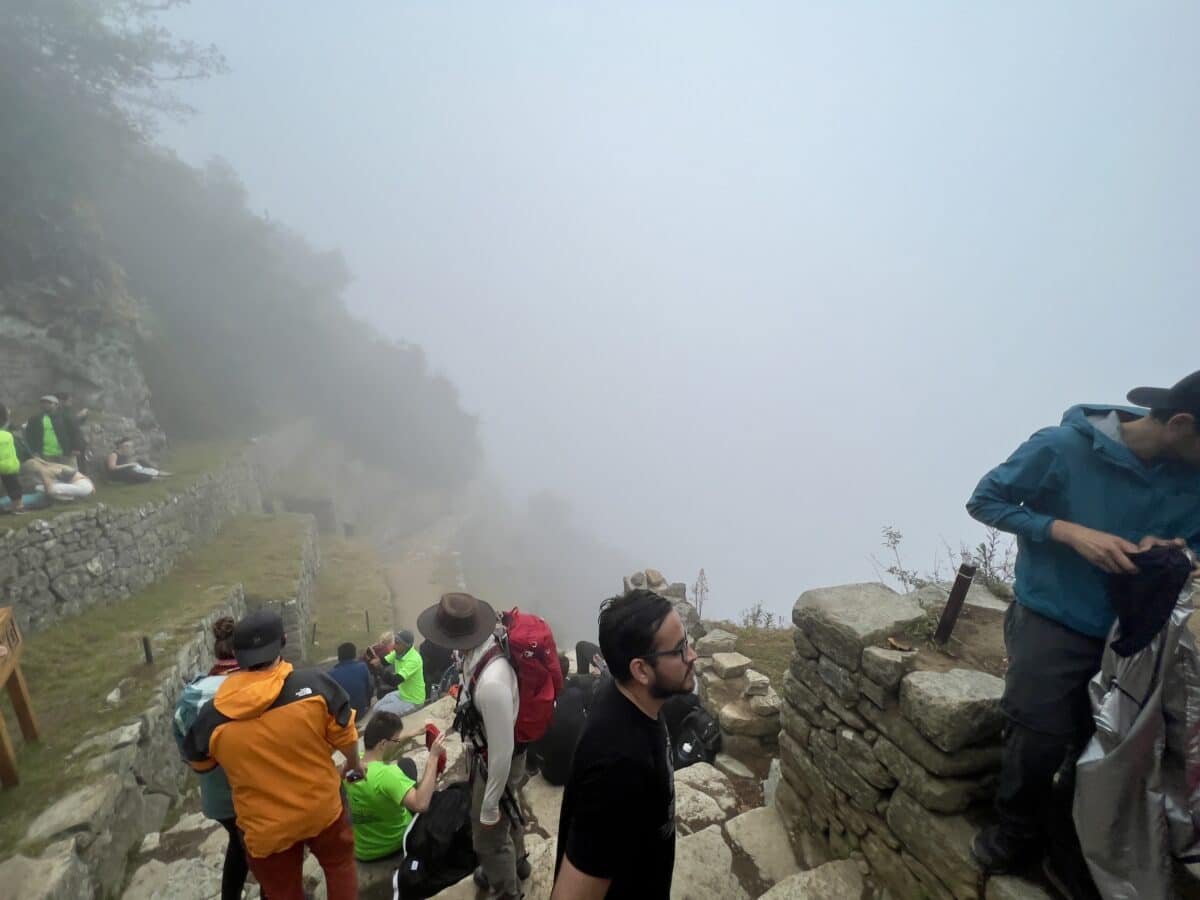
Unfortunately, this is the risk you run when you go during the rainy season, although it can happen during the dry season as well. So just prepare yourself that you might not get that incredible view from the Sun Gate.
Exploring Machu Picchu
After descending from the Sun Gate, you’ll have the opportunity to explore the magnificent Machu Picchu. There is also another viewpoint of Machu Picchu before you enter the site. So don’t worry if you can’t see it from the Sun Gate!
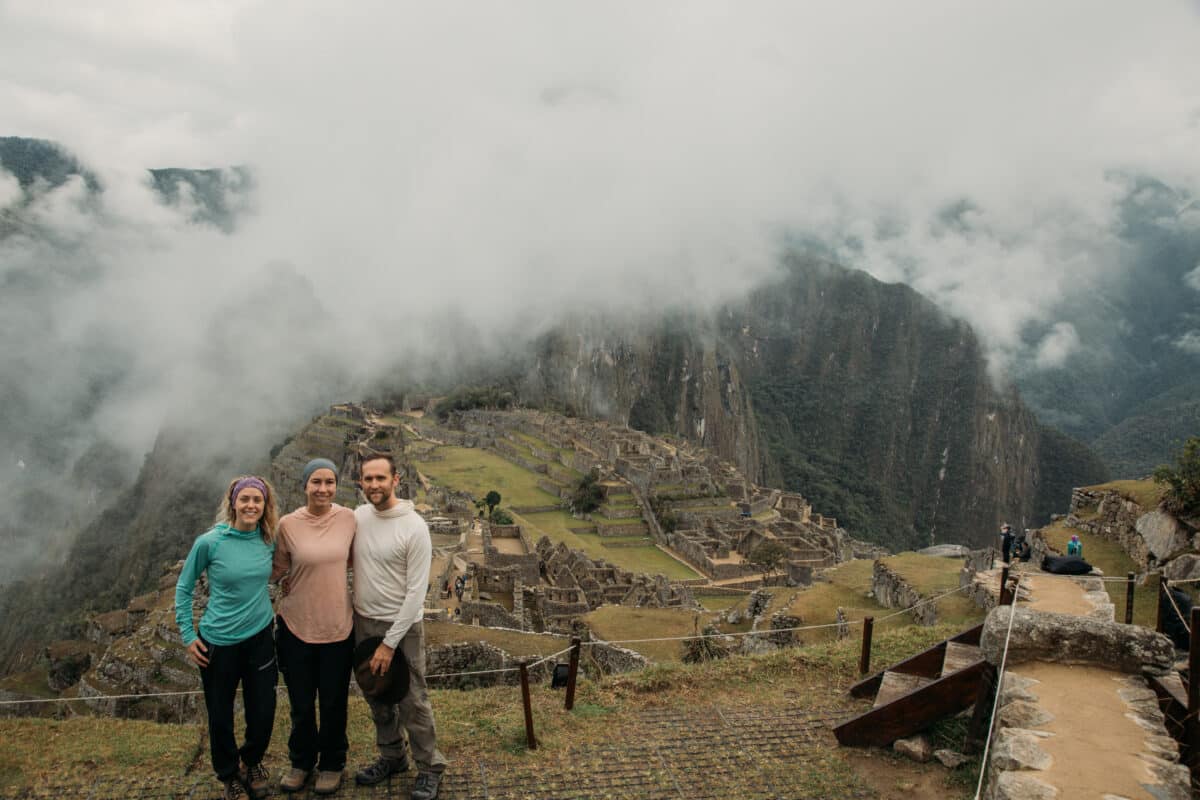
After you take in the views, your guide will take you through the most significant buildings and provide insights into the history and culture of this remarkable Inca site. You’ll then have free time to explore on your own.

And while the morning started off chilly, Machu Picchu was VERY hot by the time we arrived. We got down to the least amount of layers we could this morning!
Off to Aguas Calientes
After you’re done exploring Machu Picchu, most tour companies will have you take the bus back to Aguas Calientes, which is the closest town to Machu Picchu. You’ll have lunch at a local restaurant and then check into your hotel.
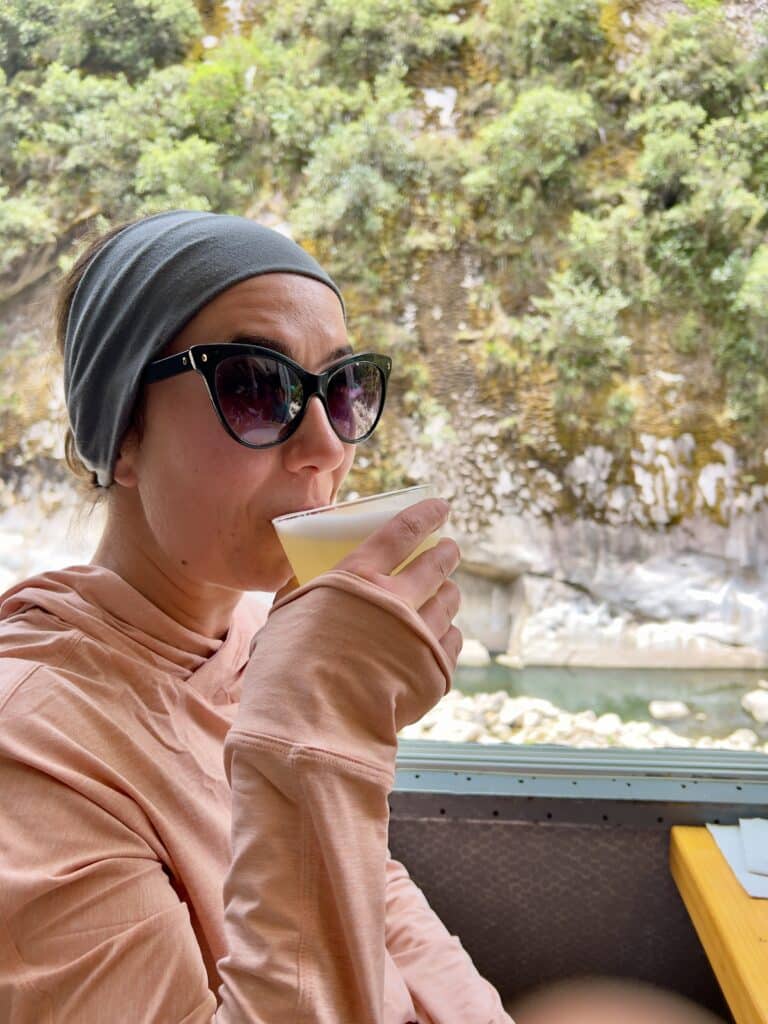
We stayed at the El MaPi Hotel by Inkaterra and highly recommend it! It was very new and clean and had a lovely restaurant, bar, and spa on site. The next morning, we treated ourselves to massages, and it was the perfect way to end this experience!
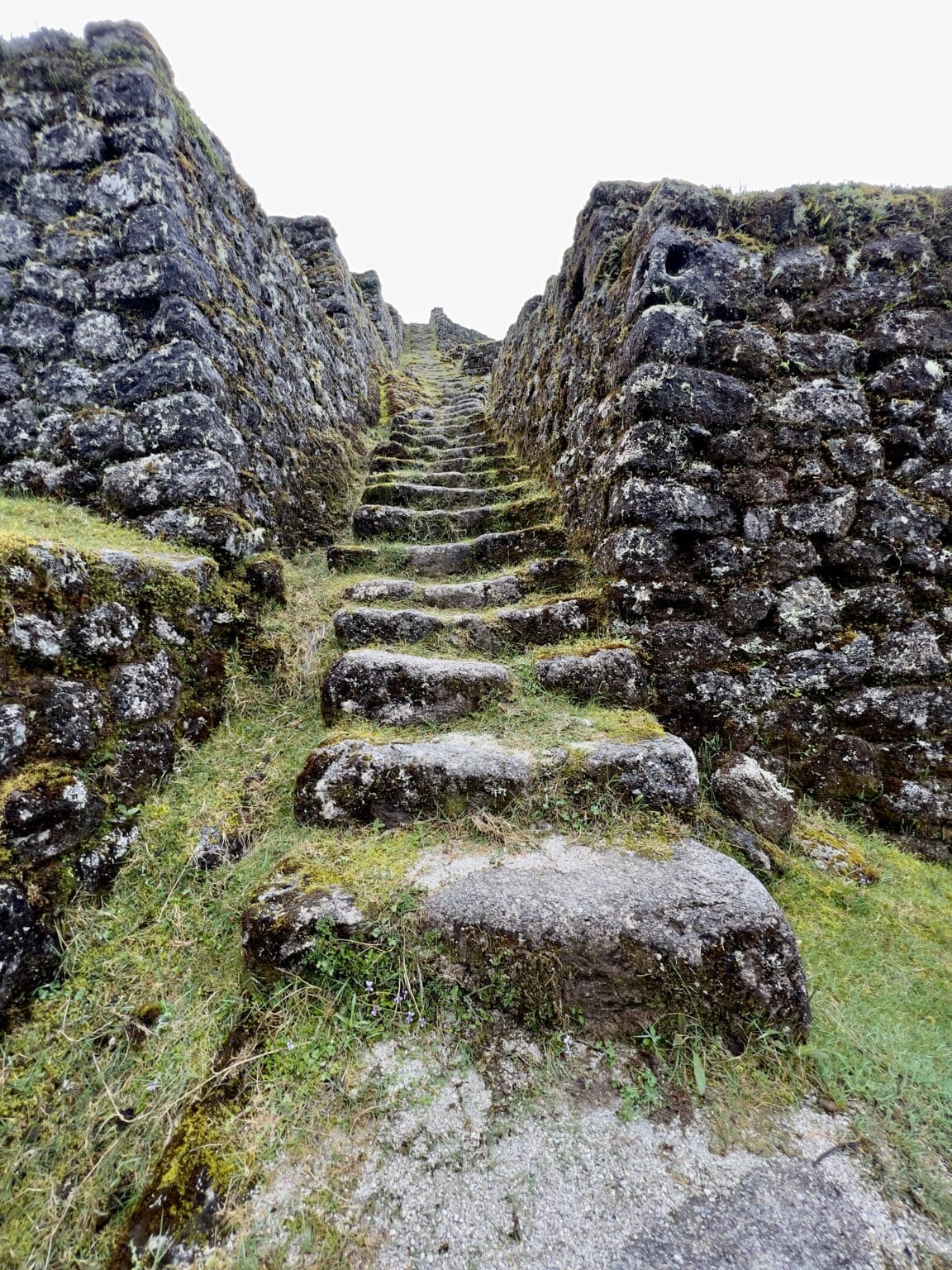
So, Was the Inca Trail Worth It?
YES! I would do it again in a heartbeat. The Inca Trail was one of my favorite travel experiences to date by far. The people, the views, the ancient sites, the food, the challenge, all of it was amazing.
I enjoyed this experience so much that I am now getting ready to do the Everest Basecamp hike in Nepal.
If anyone has any questions about the Inca Trail or visiting Peru in general, don’t hesitate to let me know in the comments. Check out my photo gallery of our trek below and see my Inca Trail YouTube video here.
- Read more: Ultimate Inca Trail Packing List for Women & Men: DON’T Forget These Things
- Read more: 20+ Amazing Things to Do in Cusco, Peru + Day Trips You Won’t Want to Miss
- Read more: Hiking Rainbow Mountain in Peru: Your Ultimate Travel Guide for 2024
- Read more: 15 Things to Do in Peru for an Unforgettable Trip
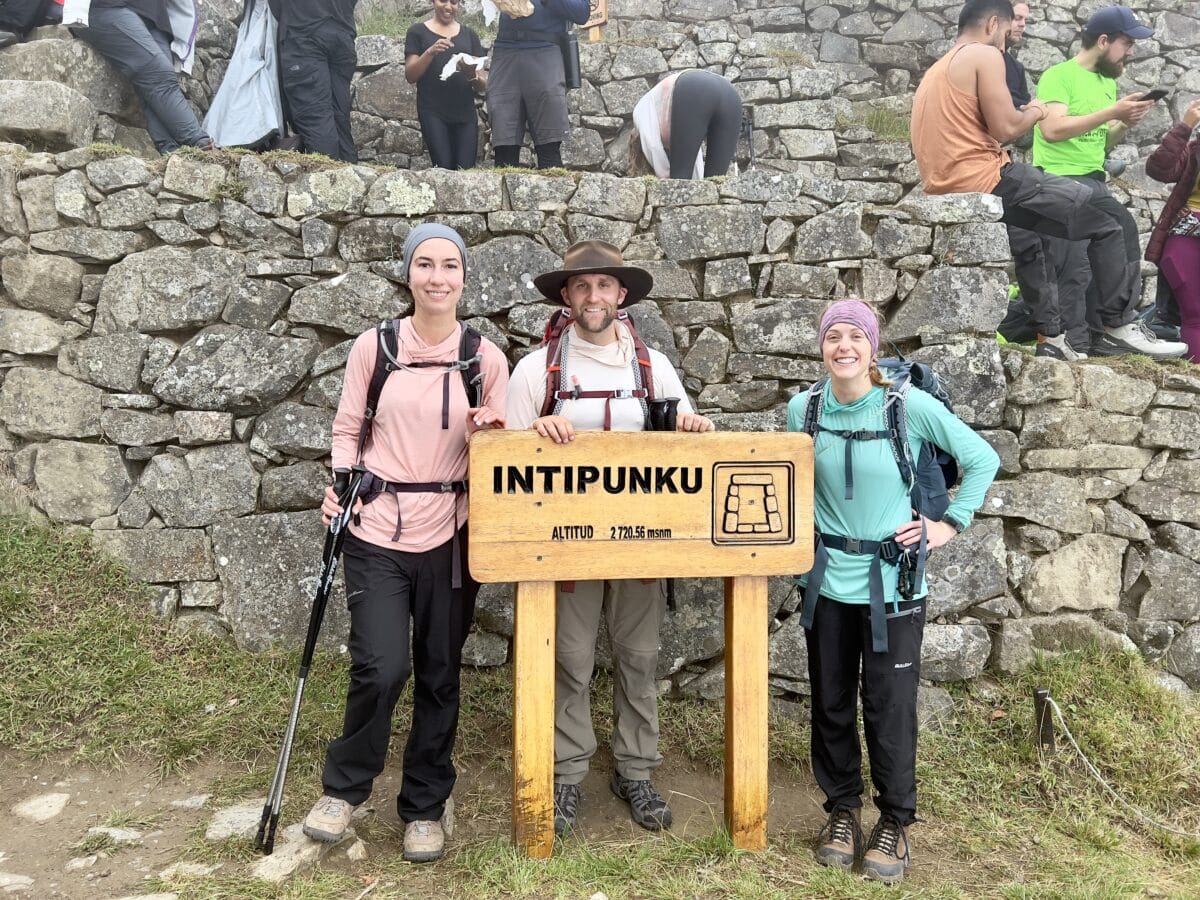

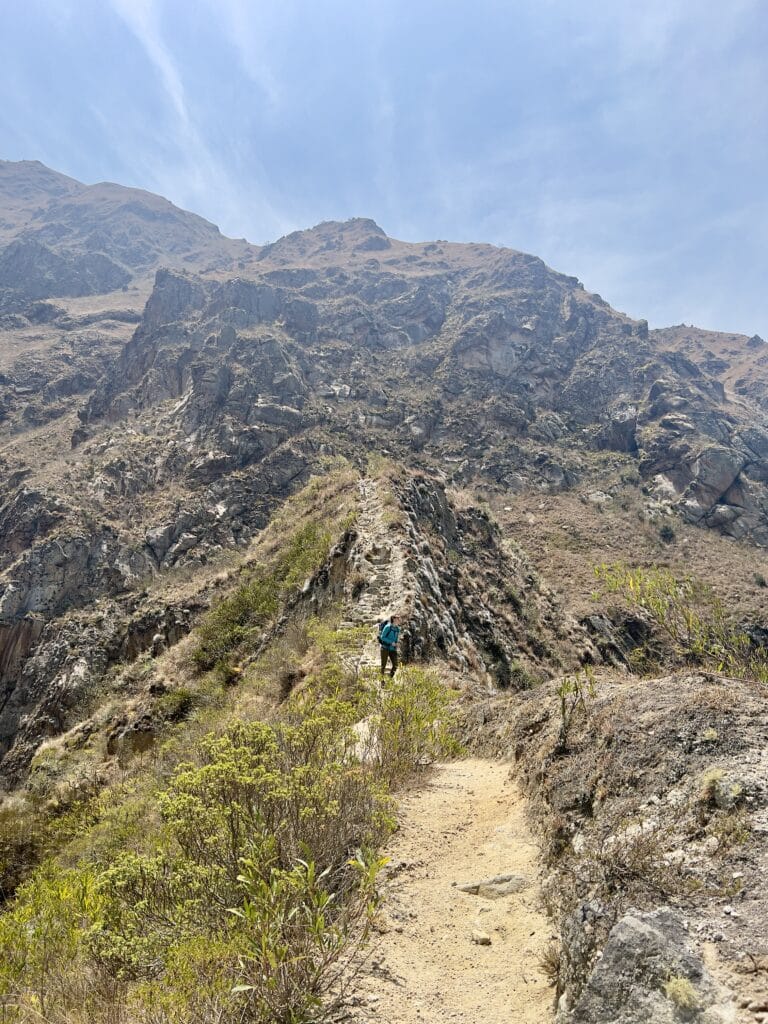
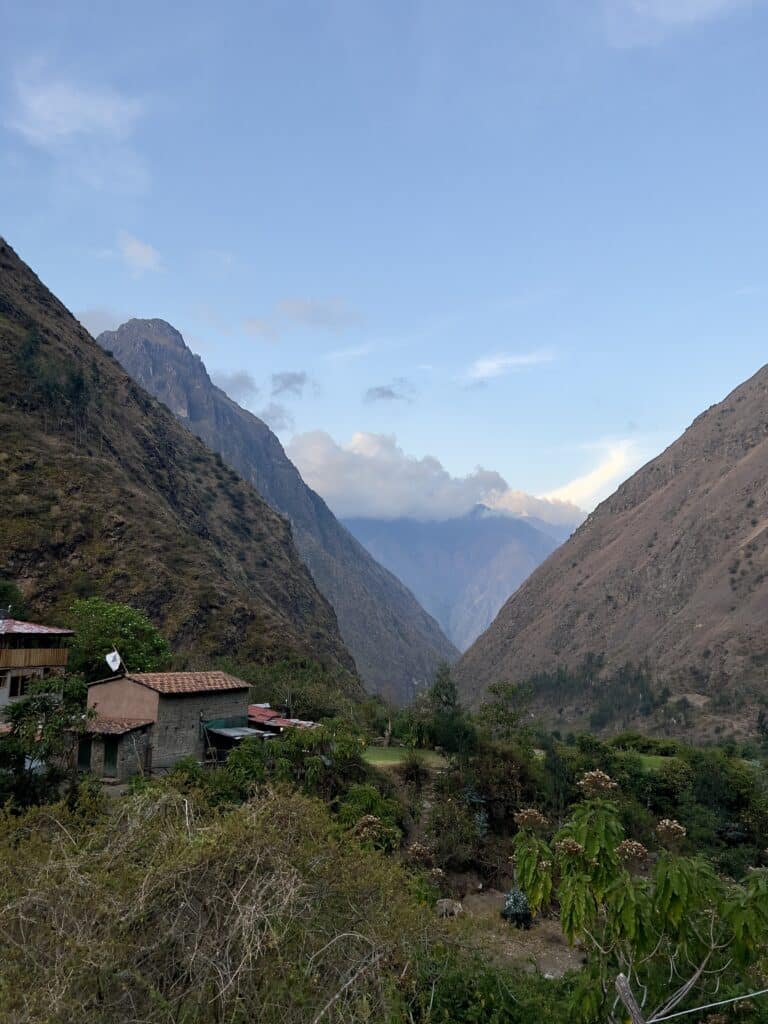
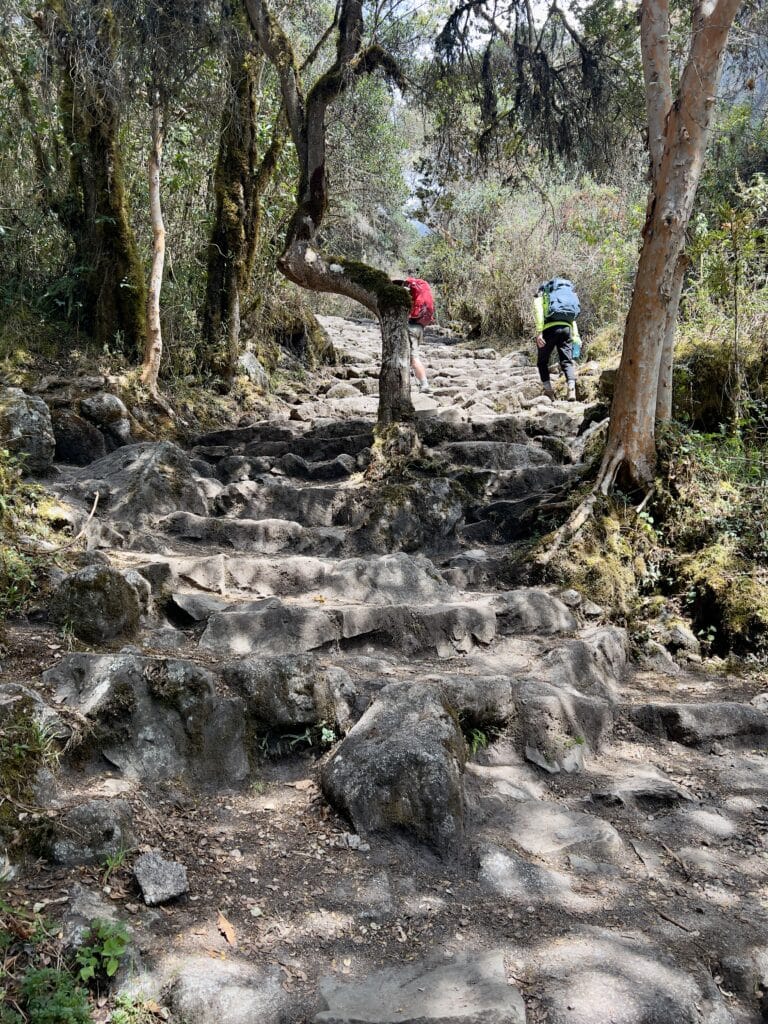
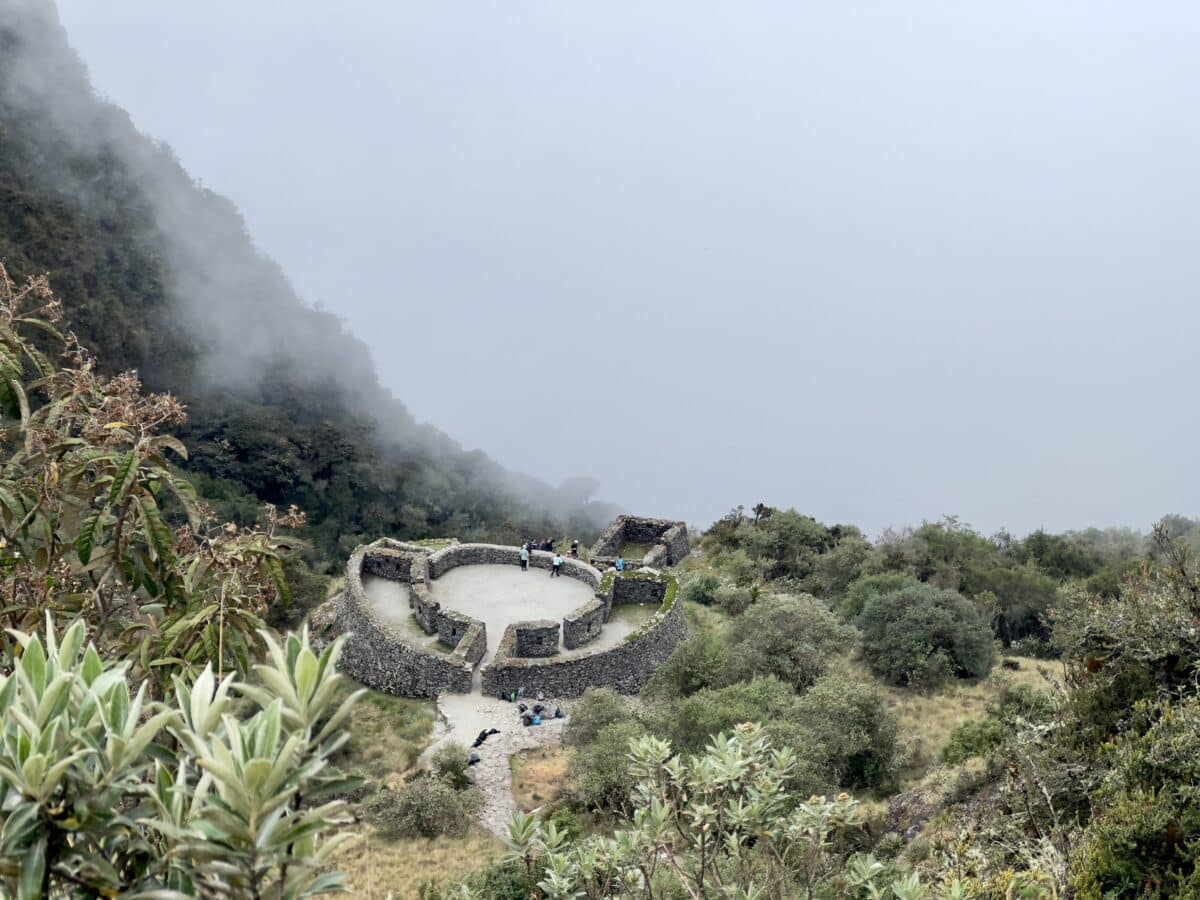


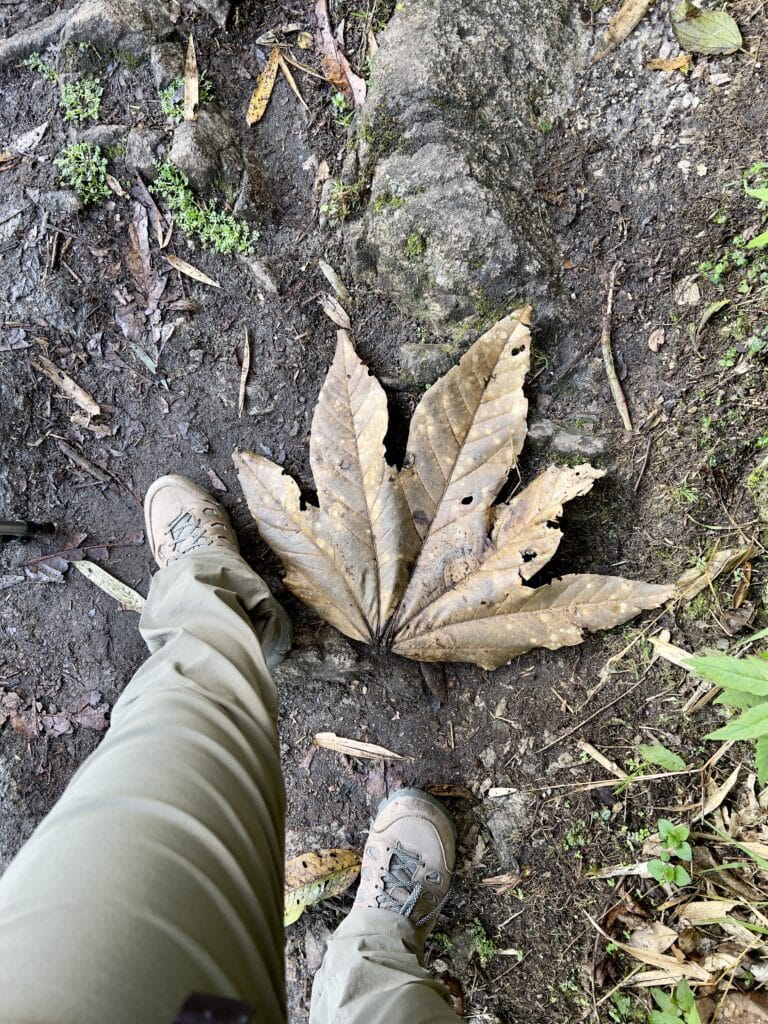
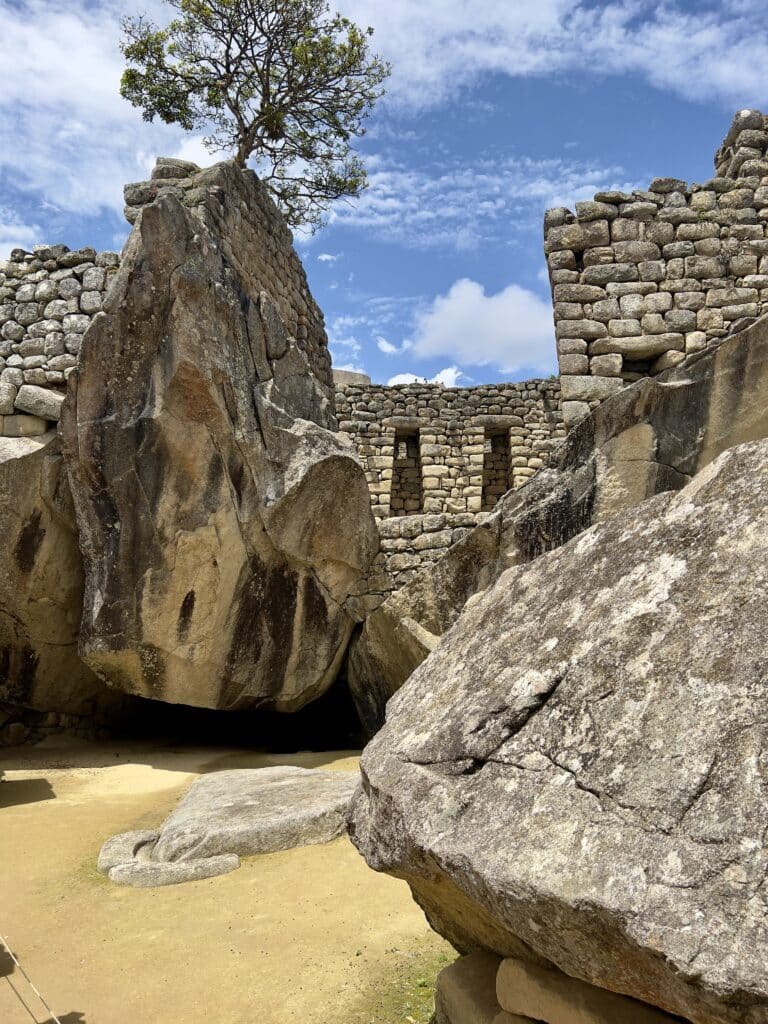







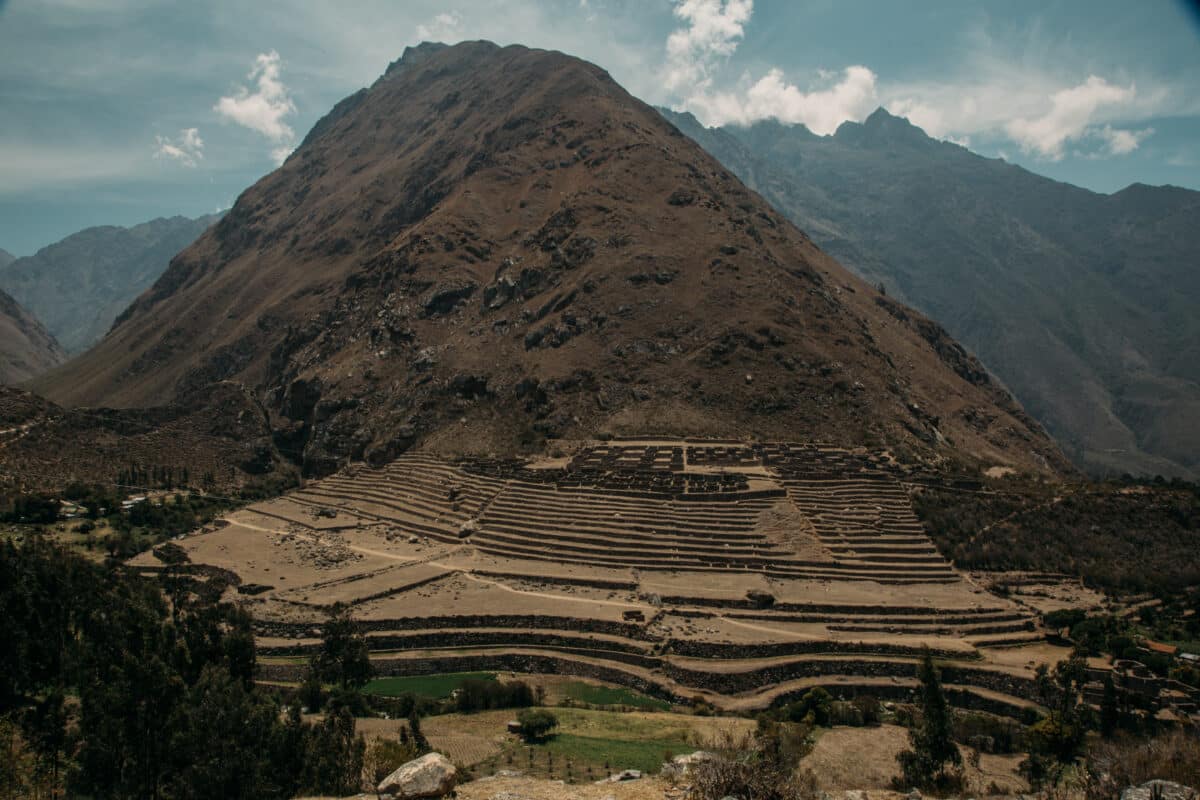


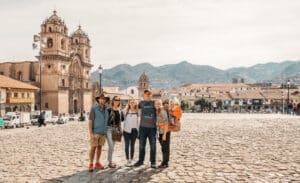
What a beautiful place. I’ll be adding it to my bucket list.